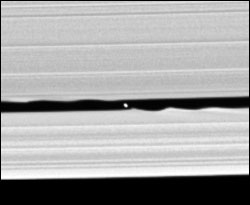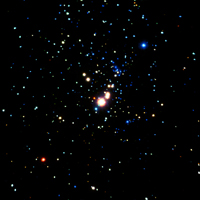This area deals with the fundamental laws and building blocks of nature and how they interact, the properties and the behavior of matter, and research into space and time and their structures.
innovations-report provides in-depth reports and articles on subjects such as astrophysics, laser technologies, nuclear, quantum, particle and solid-state physics, nanotechnologies, planetary research and findings (Mars, Venus) and developments related to the Hubble Telescope.

The NASA/ESA/ASI Cassini spacecraft has confirmed earlier suspicions of an unseen moon hidden in a gap in Saturn’s outer A ring. A new image shows the new moon and the waves it raises in the surrounding ring material.
The moon, provisionally named S/2005 S1, was first seen in a time-lapse sequence of images taken on 1 May 2005, as Cassini began its climb to higher inclinations in orbit around Saturn. A day later, an even closer view was obtained, which allowed the moon’

Thanks to a manoeuvre performed on 10 May 2005 at 20:20 CET, ESA flight controllers have successfully completed the deployment of the first boom of the MARSIS radar on board ESA’s Mars Express spacecraft.
After the start of the deployment of the first 20-metre boom on 4 May, analysis by flight controllers at ESA’s European Space Operations Centre, Darmstadt, Germany, had shown that although 12 out of the 13 boom segments were in place, one of the outermost segments, pos

NASA’s launch of the NOAA-N environmental satellite for the National Oceanic and Atmospheric Administration (NOAA) was postponed for 24 hours due to high winds. Launch is scheduled at 6:22 a.m. EDT, Thursday, May 12 pending favorable weather conditions.
Surface wind at the time of the rollback of the gantry surrounding the Boeing Delta II launch vehicle was as high as 36 knots. That was approximately seven knots above the limits at Space Launch Complex 2, Vandenberg Air Forc

Scientists at the University of North Carolina at Chapel Hill and a UNC start-up company, Xintek, Inc., have invented a new X-ray device based on carbon nanotubes that emits a scanning X-ray beam composed of multiple smaller beams while also remaining stationary.
As a result, the device can create images of objects from numerous angles and without mechanical motion, which is a distinct advantage for any machine since it increases imaging speed, can reduce the size of the devic

Scientists at the University of Nottingham have successfully levitated diamond and some of the heaviest elements, including lead and platinum. Using liquid oxygen to increase the buoyancy created by a specially designed superconducting magnet, they could now levitate a hypothetical object with a density 15 times larger than that of the densest known material, osmium. This research is published today (11th May 2005) in the New Journal of Physics co-owned by the Institute of Physics and Deutsche P

Planetary protection: X-ray super-flares aid formation of ’solar systems’
New results from NASA’s Chandra X-ray Observatory about the Orion Nebula imply super-flares torched our young solar system. Such X-ray flares likely affected the planet-forming disk around the early sun, and may have enhanced the survival chances of Earth.
By focusing on the Orion Nebula almost continuously for 13 days, a team of scientists used Chandra to obtain the deepest X-ray observations eve